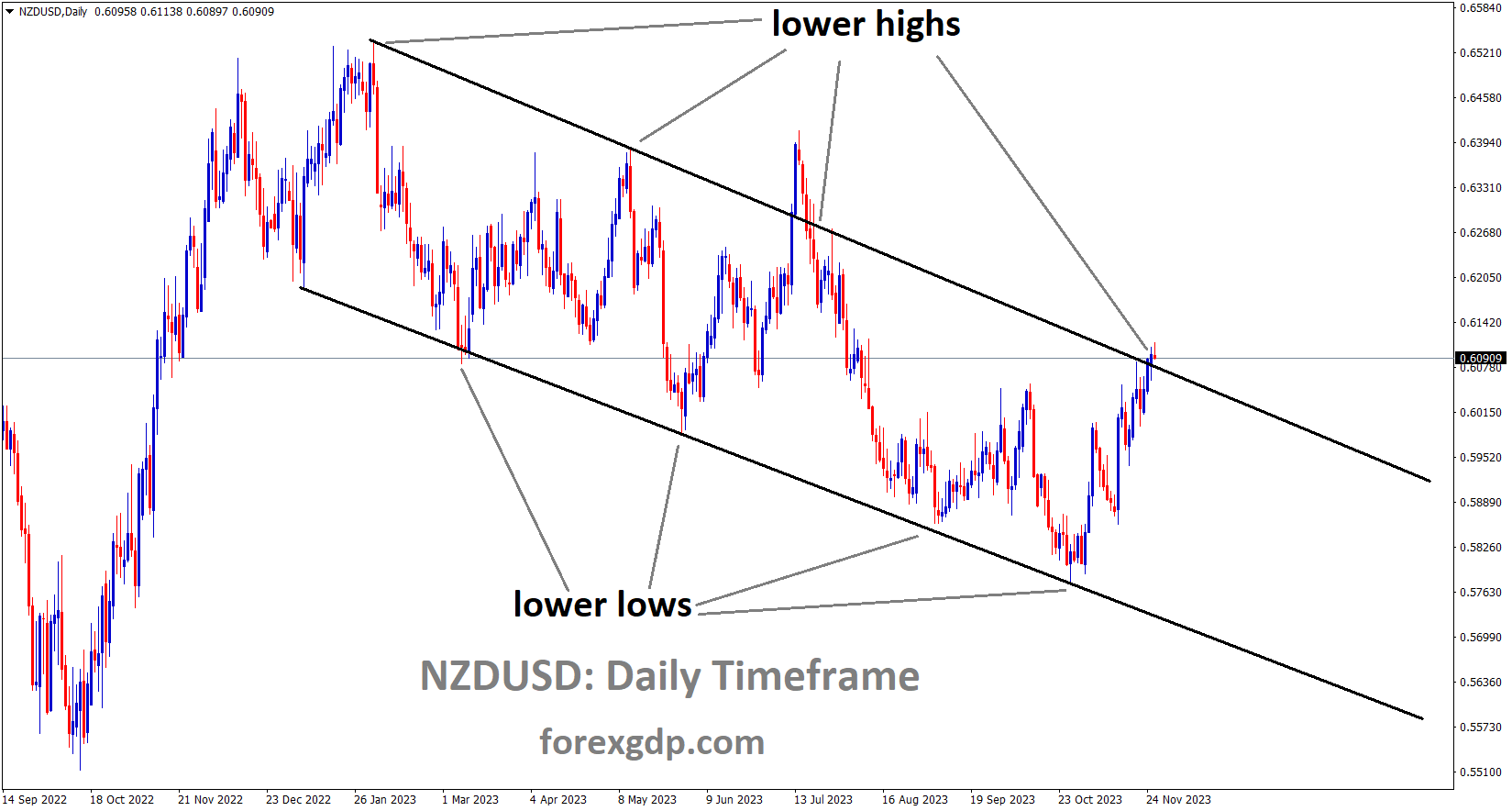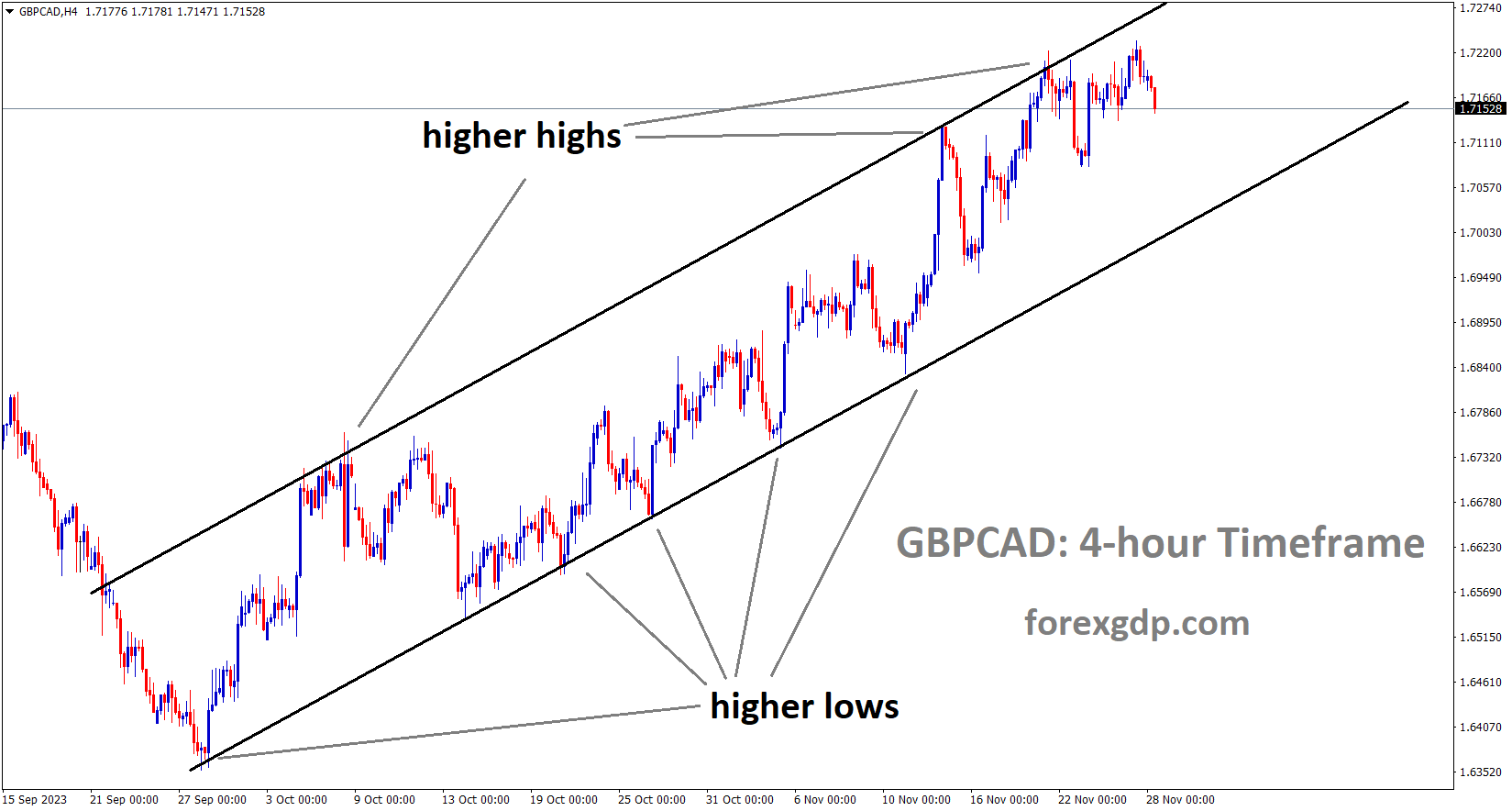NZDUSD Analysis:
NZDUSD is moving in the Descending channel and the market has reached the lower high area of the channel
The New Zealand Dollar is on the rise in anticipation of the upcoming Reserve Bank of New Zealand meeting tomorrow. On one hand, China’s stimulus plan is proving beneficial for New Zealand exports, while on the other hand, US home sales in October witnessed a 5.6% month-on-month decline, falling to 679K, which is worse than the expected 725K.
The NZDUSD uptick is supported by the overall weakness of the US Dollar. The focal point of the week is the upcoming monetary policy meeting of the Reserve Bank of New Zealand on Wednesday. The New Zealand central bank is anticipated to maintain its overnight cash rate at 5.50% for the fourth consecutive meeting, with speculation about a potential future rate cut, although the specific timing remains uncertain. Additionally, the recently announced Chinese stimulus plan aimed at boosting the property sector contributes to providing some support for the New Zealand Dollar, known as a China-proxy currency.
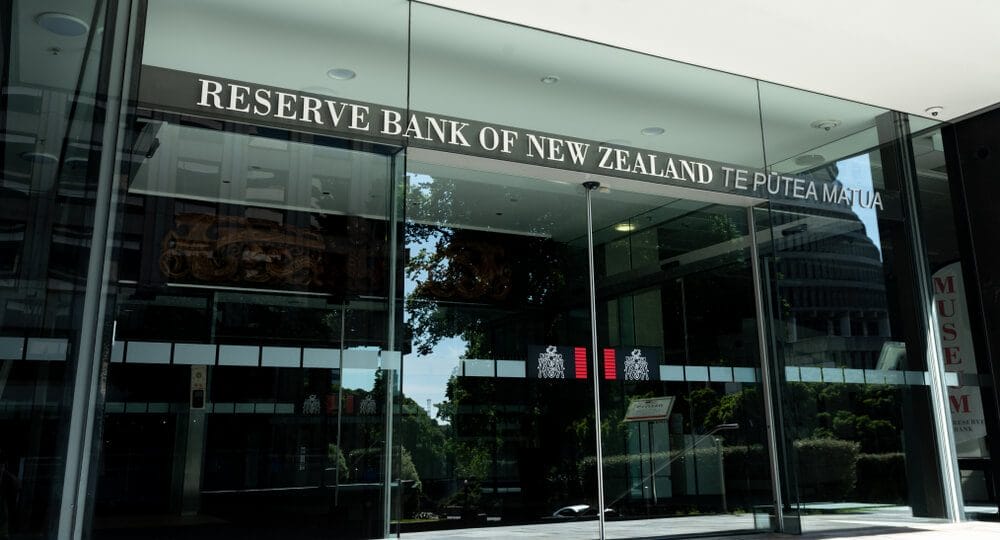
On the US Dollar front, Monday’s housing data indicated that higher mortgage rates had a negative impact on demand in October. The Census Bureau and the Department of Housing and Urban Development reported a 5.6% month-on-month decline in New Home Sales to 679K in October, falling short of the expected 725K. Concurrently, the Dallas Fed Manufacturing Index for November was reported at -19.9, compared to the previous -19.2. The softer US data exerts downward pressure on the Greenback, acting as a favorable factor for the NZDUSD pair. Tuesday brings a focus on additional US data, including the Housing Price Index, S&P/Case-Shiller Home Price Indices, CB Consumer Confidence, and the Richmond Fed Manufacturing Index. Attention will then shift to the RBNZ’s interest rate decision on Wednesday. These events hold the potential to introduce volatility to the market and establish a clearer direction for the NZDUSD pair.
GOLD Analysis:
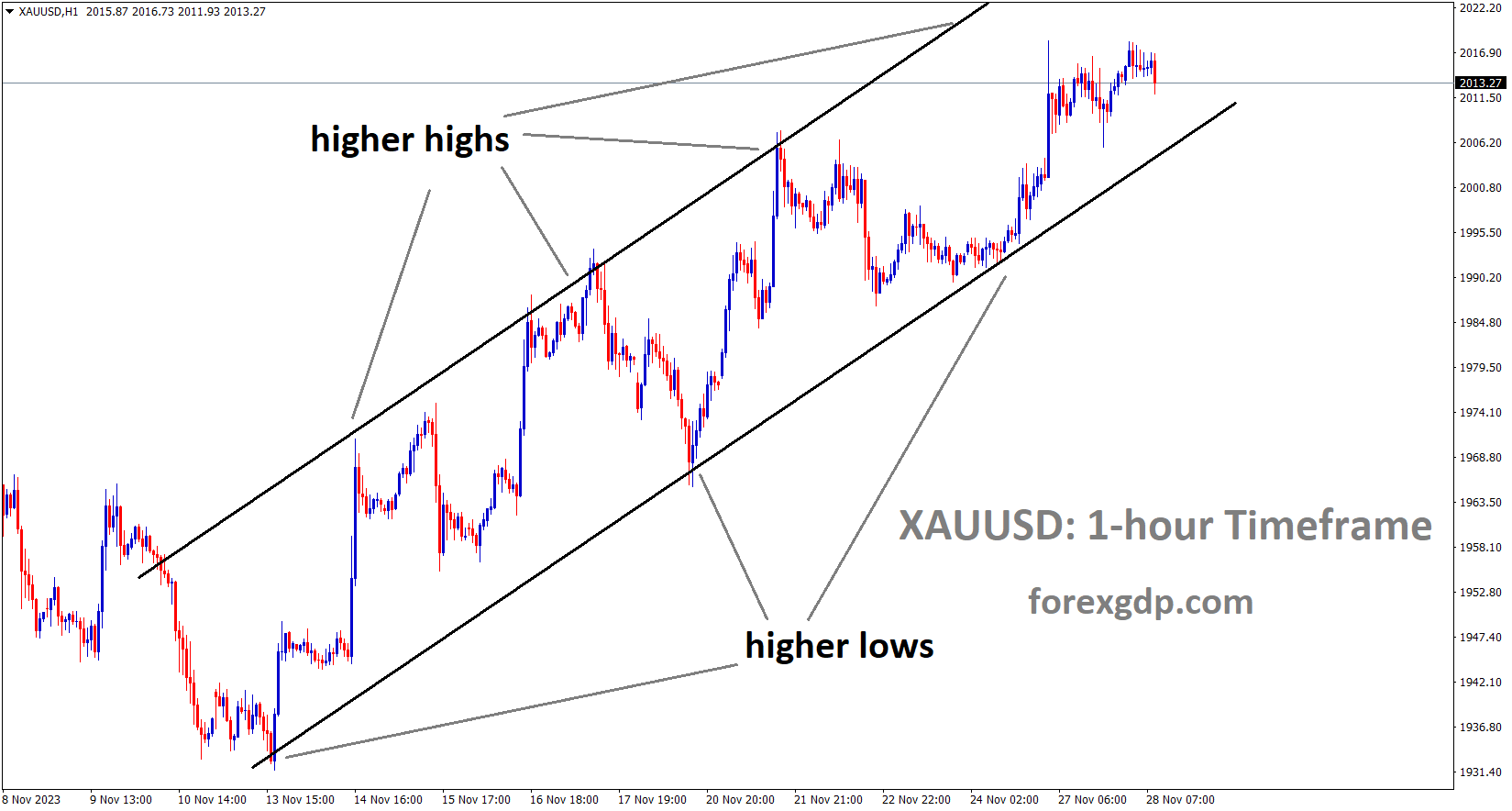
XAUUSD Gold price is moving in an Ascending channel and the market has reached the higher high area of the channel
Gold prices are rising due to expectations of a dovish stance from the Federal Reserve regarding monetary policies. Additionally, the injection of stimulus measures into the real estate sector by China is contributing to the upward movement in gold prices.
The price of gold successfully breached the horizontal barrier in the $2,008-2,010 range, reaching $2,018 on Monday, marking its highest level since mid-May. Presently, the precious metal appears to be in a bullish consolidation phase, hovering just below this level as it enters the European session on Tuesday. Speculations about a potential pause in the Federal Reserve’s (Fed) monetary tightening cycle were fueled by softer US consumer inflation figures released two weeks ago. Additionally, market expectations include the possibility of a series of rate cuts in 2024, causing the US Dollar (USD) to slide to a near three-week low and supporting the ongoing uptrend in gold from sub-$1,950 levels, the monthly low observed on November 13.

Amid concerns about a global economic downturn, which typically favors traditional safe-haven assets, the short-term outlook for gold remains positive. However, a positive sentiment in Asian equity markets acts as a headwind for the precious metal. Bullish traders appear cautious, awaiting the release of the Personal Consumption Expenditure Price Index from the United States (US) for substantial impetus. Meanwhile, the Conference Board’s Consumer Confidence Index release and speeches by influential FOMC members could present short-term trading opportunities later on Tuesday. Despite these potential catalysts, the near-term fundamental backdrop appears strongly in favor of bullish traders.
The growing consensus that the Federal Reserve has concluded its rate hikes provides support for the non-yielding gold price to hold above the psychological $2,000 mark. The release of softer US consumer inflation figures two weeks ago increased expectations that the Fed would maintain current interest rates and potentially ease policy in 2024. Monday’s data indicated a larger-than-expected decline in sales of new single-family homes in the US for October, driven by higher mortgage rates affecting affordability. The benchmark 10-year US Treasury bond yield is near a two-month low, pulling the US Dollar to a nearly three-month low and benefiting XAUUSD. The looming risk of a recession adds further support to the safe-haven precious metal, although gains are capped by a positive tone in equity markets. Traders are now eagerly anticipating the Conference Board’s US Consumer Confidence Index and Fed officials’ speeches for market impetus during the North American session. Additionally, focus remains on Thursday’s release of the Fed’s preferred inflation gauge, the core PCE Price Index.
SILVER Analysis:
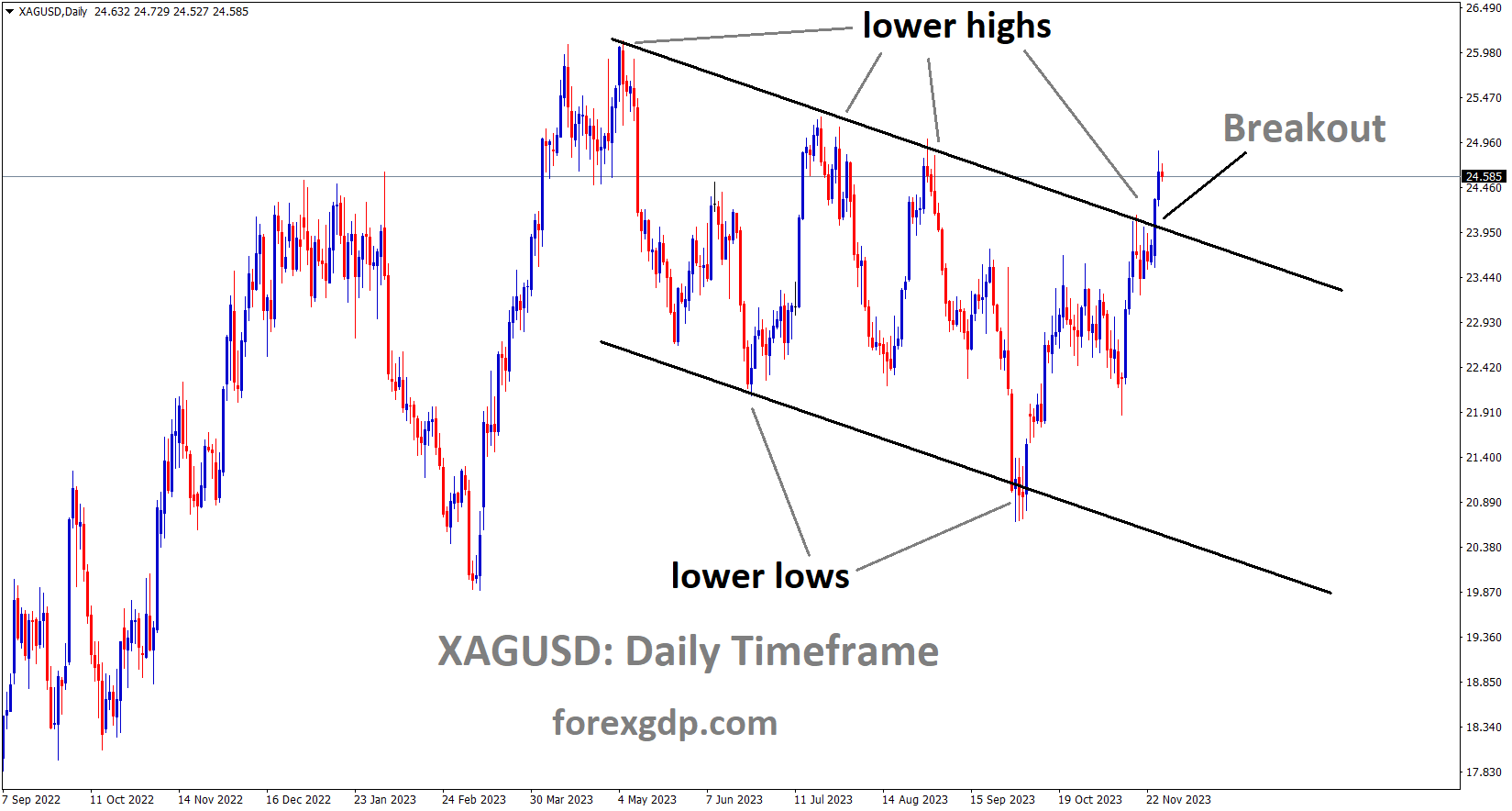
XAGUSD Silver price has broken the Descending channel in upside
The decline of the US Dollar followed disappointing domestic data in recent weeks. This week, the focus will be on the Federal Reserve’s gauge of the Core PCE index, and based on this data, we will draw conclusions regarding whether the Fed will opt for a rate hike in December or not.
The US Dollar Index is currently at 103.25, experiencing losses of nearly 0.15%. Ongoing vulnerability in the Greenback is attributed to dovish speculations concerning the future actions of the Federal Reserve, with market attention focused on Thursday’s release of Personal Consumption Expenditures figures – the Fed’s preferred gauge for inflation. Despite the release of October’s data on New Home Sales and Building Permits during the session, they did not significantly impact the dynamics of the USD. The US Dollar’s weakness stems from concerns about a cooling labor market and subdued inflation in the US economy, leading to expectations of a dovish stance by the Federal Reserve. Investors are eagerly awaiting the release of October’s PCE figures, an additional jobs report, and the November Consumer Price Index (CPI) before the December meeting, where clearer guidance from the Fed is anticipated. These forthcoming releases are expected to shape the future movements of the US Dollar.

The US Dollar is currently navigating within a neutral range, influenced by the impending PCE inflation figures and the prevailing dovish sentiment towards the Federal Reserve. In terms of recent data, New Home Sales for October fell below expectations, recording 679K compared to the anticipated 725K, as reported by the US Census Bureau. However, October brought positive news with the Building Permits figure, surpassing both previous and predicted numbers at 1.498 million. Notably, US bond yields have reversed course at the beginning of the week, with 2-year, 5-year, and 10-year yields at 4.92%, 4.44%, and 4.42%, respectively, currently hindering the USD’s upward momentum. According to the CME FedWatch Tool, markets are currently pricing in no rate hike at the December meeting, and rate swap futures indicate expectations for rate cuts in mid-2024.
USDJPY Analysis:
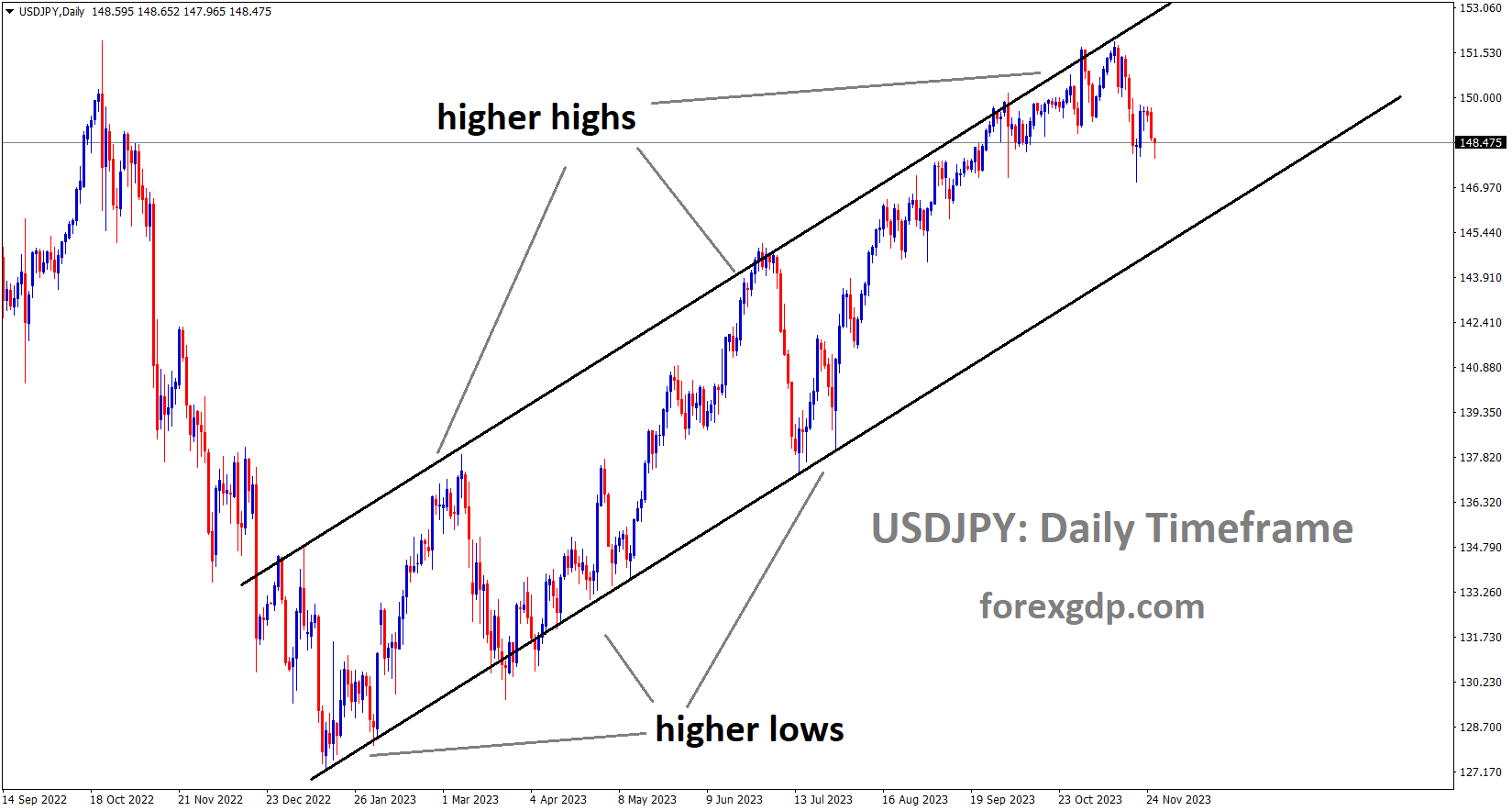
USDJPY is moving in an Ascending channel and the market has fallen from the higher high area of the channel
Last week, the Japanese Consumer Price Index for October exceeded 3%, alleviating some pressure on the Bank of Japan to raise interest rates. The anticipated rate hike from the BoJ is now expected to take place at the beginning of 2024.

The Japanese Yen concluded the trading week on a subdued note, influenced by a post-US Thanksgiving Day lull. However, Friday provided crucial information for the Bank of Japan’s (BOJ) analysis. Once again, headline inflation exceeded 2%, surpassing estimates and maintaining a level above 3%. It’s important to recall that the BOJ consistently emphasizes its desire for sustained inflation above 2%, heightening the likelihood of a potential policy shift. A hawkish move would support the yen and potentially mark the end of the negative interest rates policy.
The ongoing conflict in Israel requires close monitoring, as the JPY may garner additional support in the event of an escalation due to safe-haven demand. Looking ahead to the upcoming, the focus will shift more towards US economic data, with the core PCE deflator taking precedence as the Federal Reserve’s preferred measure of inflation. From a Japanese perspective, BoJ officials will be dispersed throughout the week, along with the release of retail sales and unemployment data.
USDCAD Analysis:
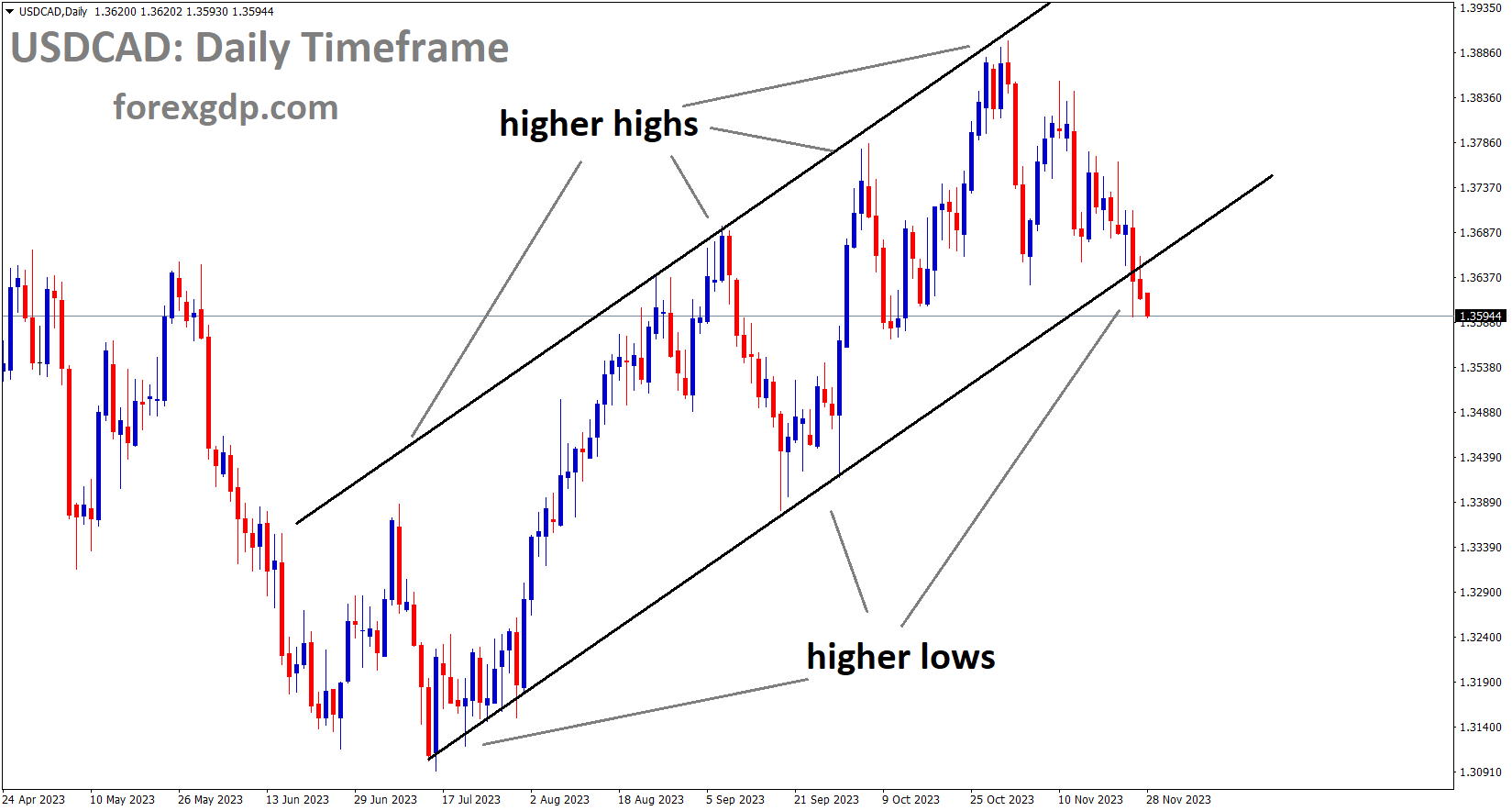
USDCAD is moving in an Ascending channel and the market has reached the higher low area of the channel
The Canadian Dollar experienced an uptick as crude oil prices rose in anticipation of the upcoming OPEC+ meeting. Additionally, this week is marked by the release of Canada’s GDP data and Employment Change figures.

The US Dollar faces downward pressure as traders factor in almost 85 basis points of cuts in 2024 by the Federal Reserve. The risk-on sentiment is further reinforced by a recent report from the US Census Bureau, revealing a significant 5.6% drop in New Home Sales for October at 679K, below the market consensus of 725K. Looking ahead, investors are likely to focus on Canada’s Gross Domestic Product on Thursday, followed by the Net Change in Employment on Friday. Additionally, Tuesday brings attention to US data, including the Housing Price Index and CB Consumer Confidence. Speeches from Federal Reserve officials during the week will offer valuable insights into the central bank’s perspective on the economic landscape.
GBPCAD Analysis:
GBPCAD is moving in an Ascending channel and the market has fallen from the higher high area of the channel
The Canadian Dollar receives some support from the rebound in crude oil prices and positive market sentiment. Western Texas Intermediate has broken a four-day losing streak, currently hovering around $75.30 per barrel. Attention is now directed towards the imminent OPEC+ meeting, with widespread expectations for a decision to deepen and extend cuts to oil production. The US Dollar Index, hitting its lowest point since late August at 103.07 on Tuesday, continues its downward trend, propelled by a decline in US Treasury yields. Notably, the 2 and 10-year bond yields have eased to 4.87% and 4.40%, respectively.
GBPUSD Analysis:
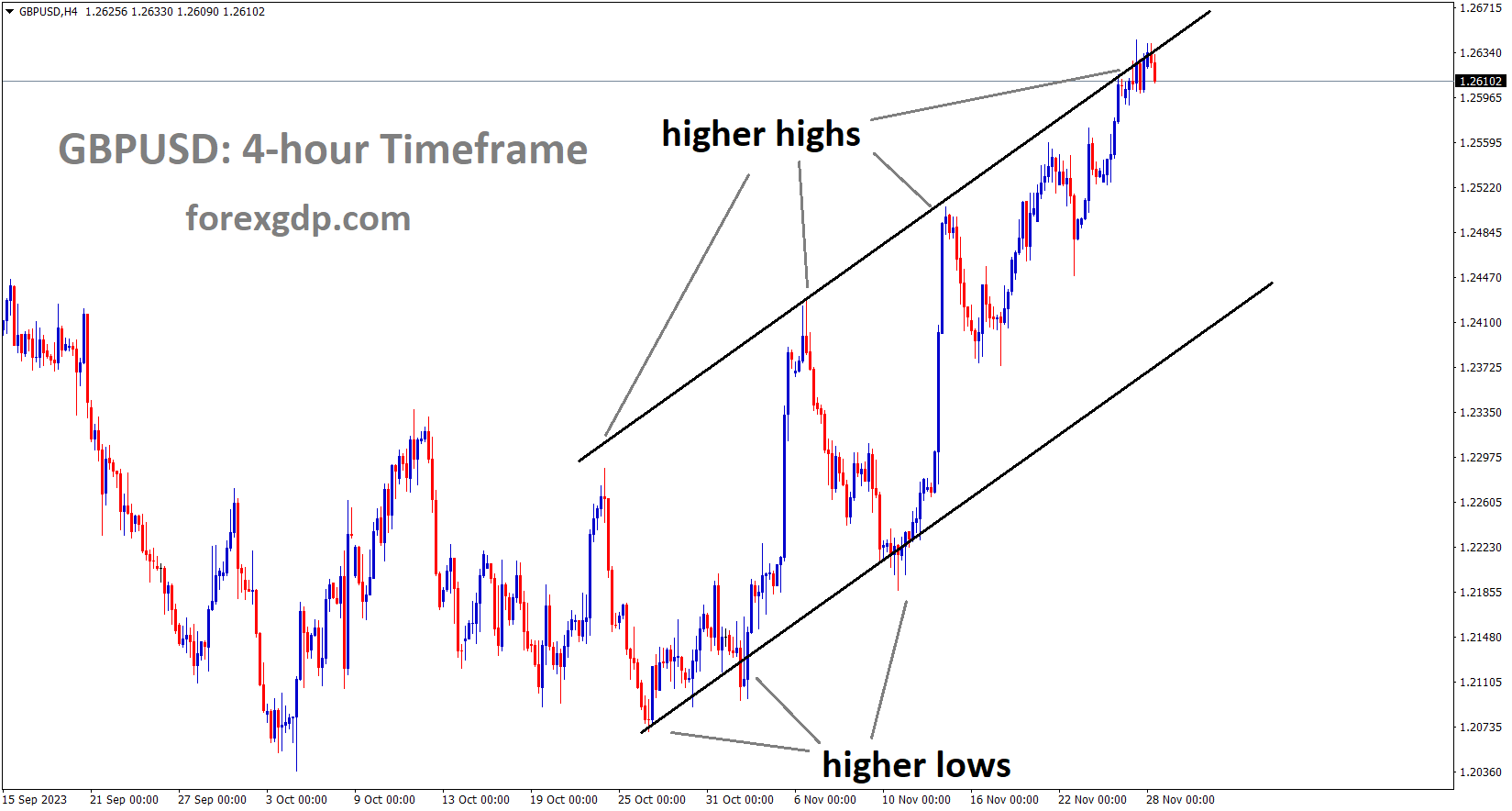
GBPUSD is moving in an Ascending channel and the market has reached the higher high area of the channel
Governor Bailey of the Bank of England noted that achieving the 2% inflation target within the next year is proving challenging. Initial projections anticipated a 4% inflation rate in the first half, with a potential decrease to 2% in the second half. Analysts are predicting a 100 basis points reduction in interest rates in 2024.
Bank of England governor Andrew Bailey issued a cautionary statement today, expressing the difficulty and time required to bring inflation back to the target of 2%.

Bailey highlighted that the present restrictive policy is negatively impacting economic growth. During an interview with ChronicleLive, he emphasized the consequences if the central bank fails to bring inflation under control, suggesting that the situation could worsen.
Looking ahead, Bailey projected that by the end of the first quarter next year, inflation might be slightly below 4%, with the challenge of achieving the remaining 2% primarily reliant on policy and monetary measures. He noted that the current policy is operating in a restrictive manner, constraining the overall economy. Considering market rate expectations, there were indications of a potential 90 to 100 basis points of rate cuts in 2024, although current probabilities suggest a more conservative estimate of around 61 basis points.
GBPCHF Analysis:
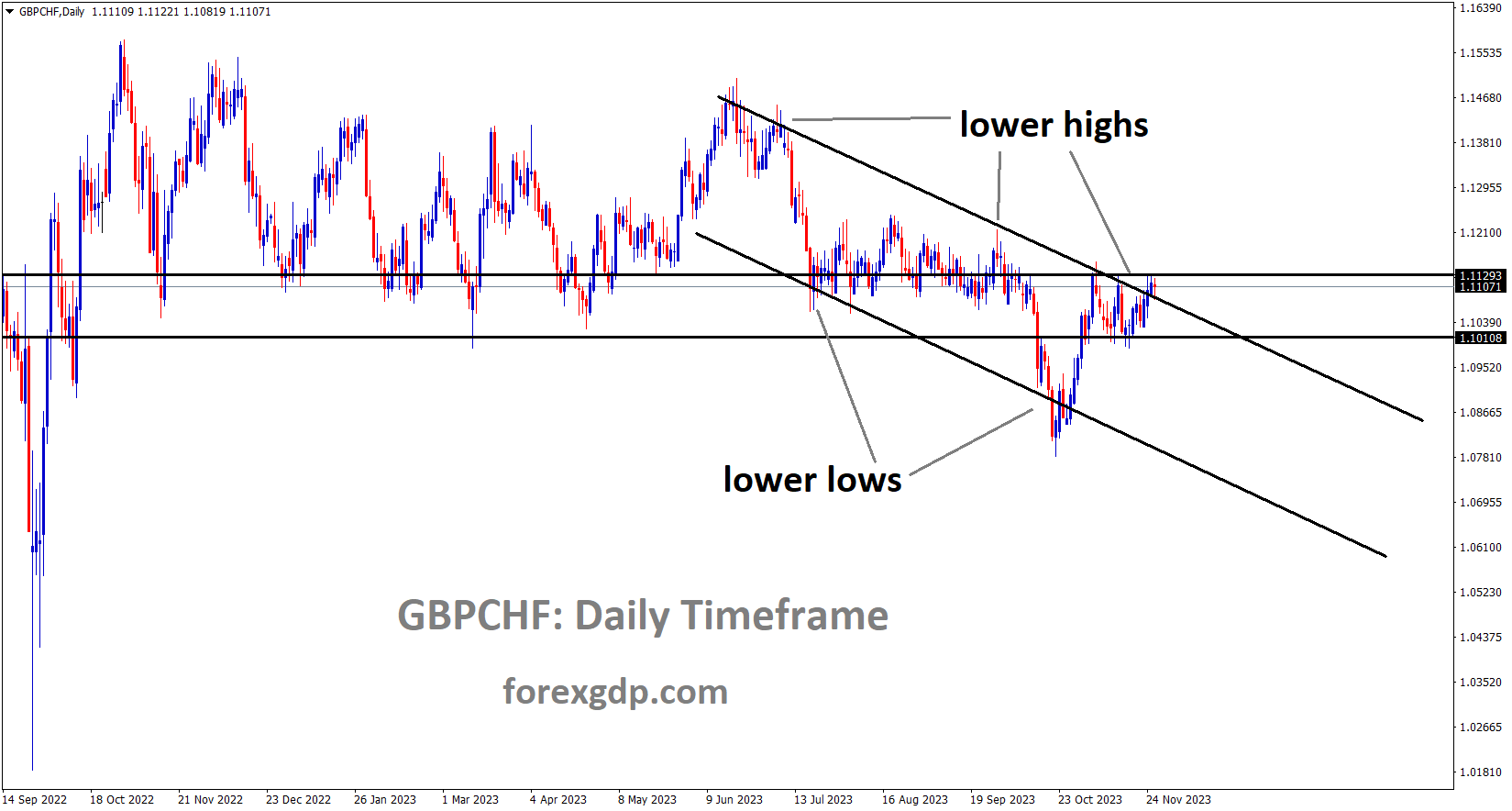
GBPCHF is moving in the Descending channel and the market has reached the lower high area of the channel
This week, the Swiss ZEW Survey is on the agenda, with last month’s October data revealing a figure of -37.8. Swiss Retail sales data, slated for Thursday, is anticipated to show improvement, with an expected increase of 0.20% compared to the previous month’s 0.60% decline. Additionally, Swiss GDP data for the third quarter is scheduled for release on Friday. The Swiss Franc has experienced a slight decrease against its counterparts following the Swiss National Bank’s announcement of reducing foreign exchange reserves compared to the previous year’s high.

The upcoming Swiss ZEW Survey Expectations on Wednesday carries particular significance as it initiates a week of notable data releases. The last reported reading in October was -37.8, indicating pervasive pessimism among businesses regarding the Swiss economy. Additionally, Swiss Real Retail Sales for October, scheduled for release on Thursday, is anticipated to show improvement, expecting a 0.2% uptick from the previous 0.6% decline. Friday will see attention on the Gross Domestic Product for the third quarter.
EURUSD Analysis:
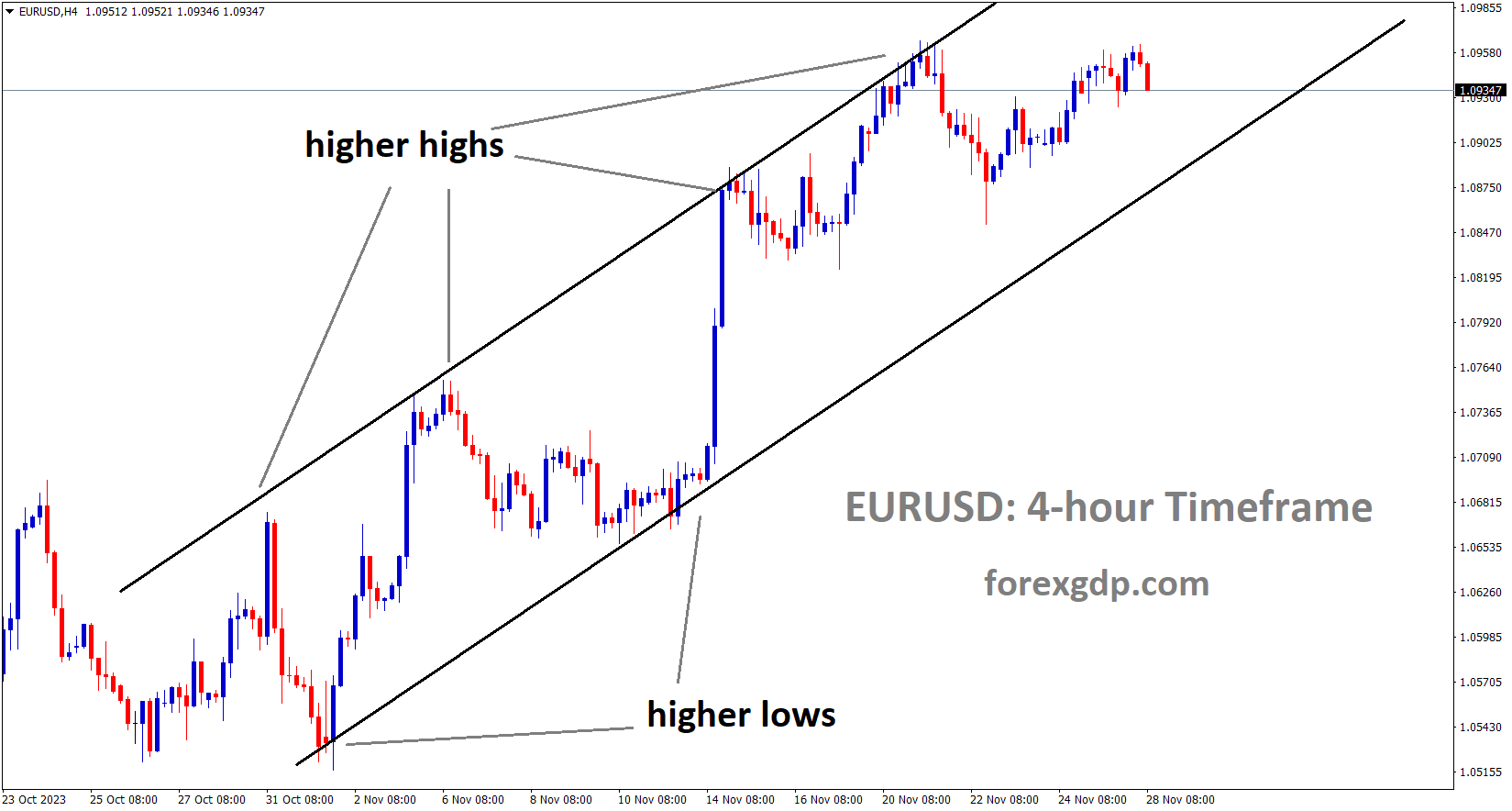
EURUSD is moving in an Ascending channel and the market has fallen from the higher high area of the channel
Societe Generale analysts predict that Euro area inflation will only decrease to 2.5% by the end of 2024. Anticipating a need for adjustments, they expect rate cuts from the European Central Bank in the first half of 2024.
According to Société Générale, the prevalent market expectation of rate cuts commencing in the first half of 2024 may be exaggerated. This view stems from the anticipation that core inflation measures in the broader European economy will manifest with slightly higher inflation, thereby preventing rate cuts from the European Central Bank. The downward momentum in inflation is expected to persist in November, potentially strengthening the narrative that the ECB will initiate rate cuts in the first half of 2024.

Nevertheless, this narrative may undergo a reversal in early 2024. As governments phase out their energy support measures, core inflation is expected to exhibit resilience, resulting in both core and headline figures only declining to 2.5% by the end of 2024. Unexpectedly robust performance in Brent crude has led to stronger energy dynamics in the short term compared to earlier forecasts. The gradual unwinding of government support measures aimed at mitigating the energy crisis, set to begin in December 2023 and conclude in May 2024, is projected to maintain headline inflation at its current levels. Although market expectations anticipate a return to 2% headline inflation in late summer 2024, Société Générale suggests that this outlook might be challenged and proven incorrect.
AUDCHF Analysis:
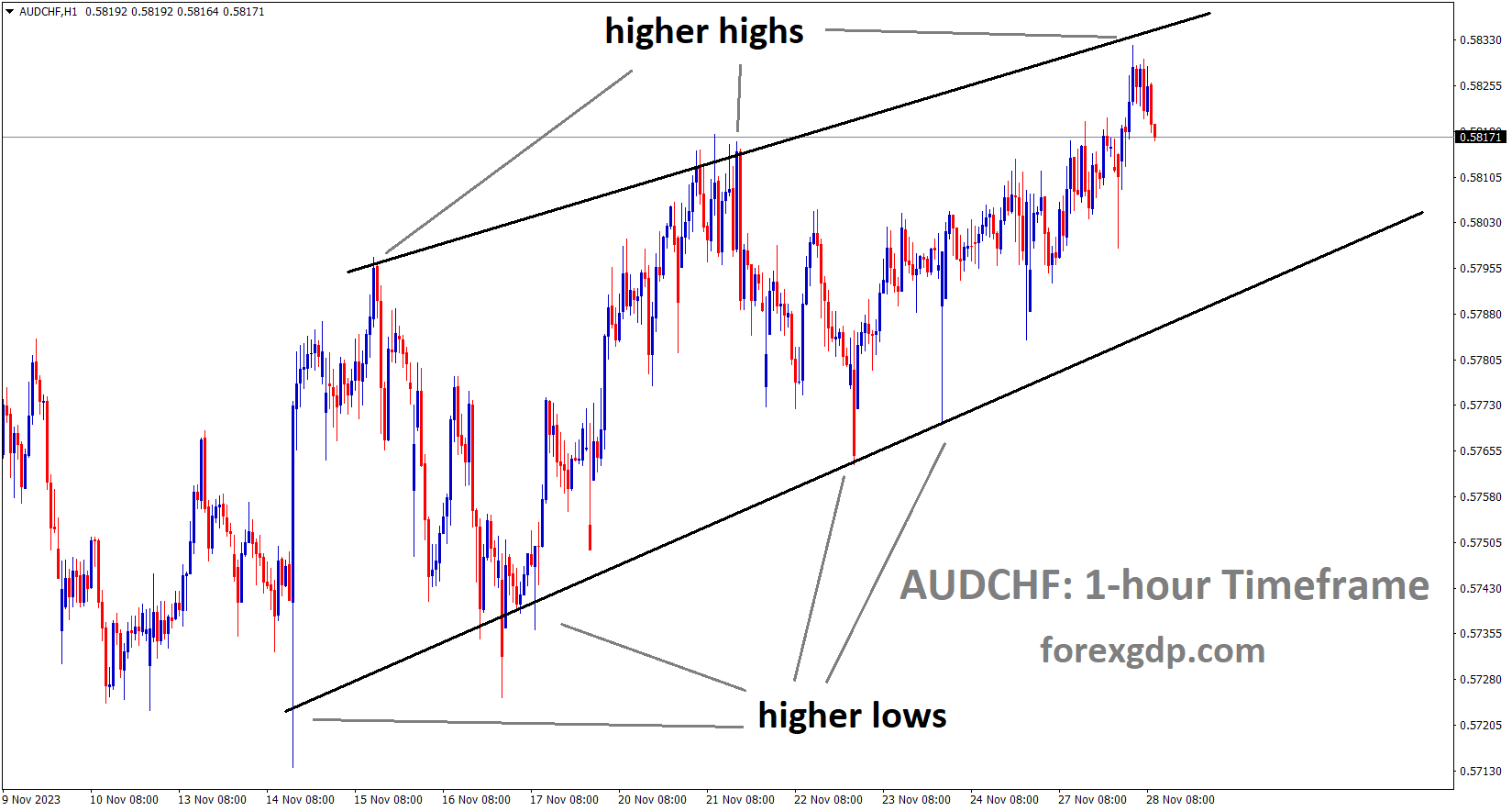
AUDCHF is moving in an Ascending channel and the market has fallen from the higher high area of the channel
According to RBA Governor Michelle Bullock, inflation in Australia is expected to decrease soon, and rate hikes are not anticipated to significantly impact employment changes. However, she emphasized that a rise in unemployment could have a more pronounced effect on the economy. Therefore, achieving a balanced economy is crucial, and rate hikes should be aligned with the income data.
Premier Li Qiang of China has stated that they will not permit any form of decoupling or disruption to supply chains. He emphasized the importance of adhering to proper rules and laws in the management of supply chains across global nations.
Reserve Bank of Australia Governor Michele Bullock engaged in a panel discussion titled Inflation, Financial Stability, and Employment at the Hong Kong Monetary Authority and Bank for International Settlements High-Level Conference in Hong Kong on Tuesday. During the discussion, she emphasized the delicate balance the central bank must strike when using interest rates to address inflation without negatively impacting unemployment.
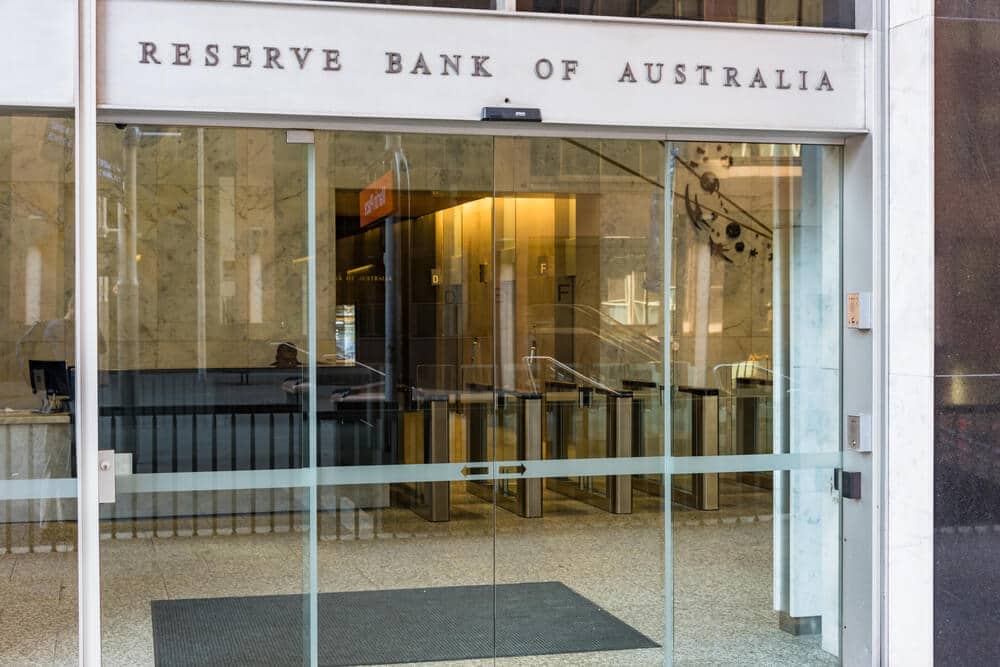
Bullock noted the importance of maintaining high employment levels, as it enables individuals to meet the financial obligations associated with more expensive mortgages.
Australia’s inflation trajectory mirrors global patterns, and the current monetary policy is characterized as restrictive. Rate increases are having a cooling effect on demand. However, the sustained demand is partly fueled by immigration, contributing to secondary effects of rising costs. Bullock highlighted the persistence of inflation in the services sector, emphasizing its resistance to easy adjustments.
China’s Premier Li Keqiang expressed Beijing’s opposition to any form of decoupling and the severing of supply chains. He conveyed China’s willingness to strengthen supply chain linkages with all countries and affirmed the country’s commitment to establishing an international business environment based on rule of law principles.
Don’t trade all the time, trade forex only at the confirmed trade setups.
Get more confirmed trade setups here: forexgdp.com/buy/

